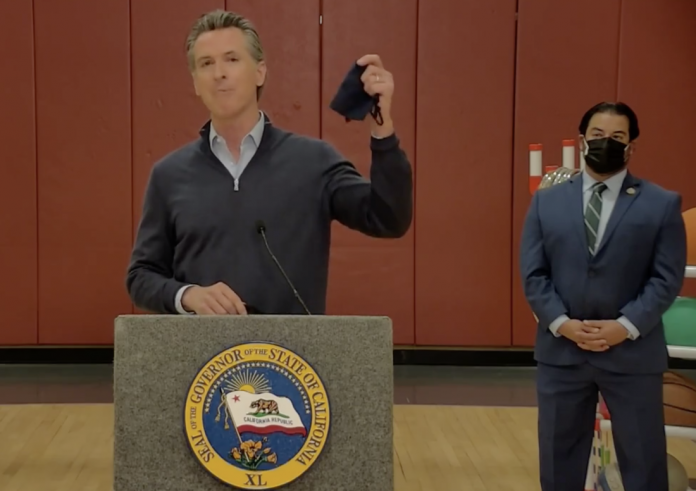SANTA CRUZ COUNTY—California Gov. Gavin Newsom at a Thursday press conference announced that 40 percent of the state’s vaccination doses will be prioritized for disadvantaged communities, a move he said was needed to address the disproportionate impact that the novel coronavirus has had on Latinx people across the state.
The state mandate that requires 70 percent of vaccines go to those 65 and older and the rest be used for essential workers still stands, Newsom said. But now counties across the state will need to use nearly half of their doses in communities in the lowest quartile of the state’s Healthy Places Index (HPI).
The HPI provides overall scores and data that predict life expectancy and compare community conditions that shape health across the state. In Santa Cruz County, most of Watsonville falls in the lowest quartile of the HPI. Neighboring Pajaro, which is under Monterey County’s jurisdiction, also falls in that quartile.
The initial goal of the new mandate is to deliver a minimum of 2 million doses to the hardest-hit quarter of the state, Newsom said. Currently, the state has delivered 1.6 million doses to those communities. The California Department of Public Health (CDPH) estimates that it will reach 2 million doses sometime in the next two weeks.
When that happens, Newsom said, the CDPH will slightly loosen its four-tiered, color-coded reopening system, allowing slightly higher case rates so that counties can move more rapidly to less restrictive tiers. The tiered system could loosen again when 4 million doses have been administered in those communities, Newsom said.
County health officials at a Thursday press conference said it is unclear how the mandate may impact their distribution, but that they have already focused a “good portion” of their doses in the Watsonville area.
What the mandate does do, County Health Services Agency Director Mimi Hall says, is strengthen its resolve in its distribution plan, which has prioritized older adults along with South County and Latinx residents.
Newsom said that the state on average over the last seven days has administered 224,000 vaccines per day, and that nearly 10 million of roughly 40 million Californians have received at least one dose of the Covid-19 vaccine.
He also said that the state has partnered with more than 300 nonprofits to conduct outreach to disadvantaged communities timid about receiving the vaccine or having a hard time getting the shot.
“All of that said, we’re still falling short,” Newsom said. “All of that said, we’re not meeting our goals.”
According to state data, 40 percent of Covid-19 cases and deaths have occurred in the lowest quartile of the HPI. The rate of infections for households making less than $40,000 per year (11.3 percent) is more than double that of households with an income of $120,000 or more (5.2 percent). At the same time, California’s wealthiest populations are being vaccinated at nearly twice the rate of its most vulnerable populations.
Newsom also emphasized the toll the pandemic has had on Latinx communities. According to state data, bout 55 percent of the state’s 3.4 million cases have been in people of Latinx descent. Those Californians have also accounted for roughly 46 percent of the state’s 53,048 Covid-19-related deaths.
Local data closely mirrors those numbers. About 52 percent of the county’s 14,760 cases have been reported in Watsonville. In addition, Latinx residents make up 54 percent of cases when county data is filtered by ethnicity.
The county has administered more than 88,000 vaccinations, and 17.4 percent of those vaccines have gone to Latinx residents. White residents have received 43.8 percent of the county’s vaccines.
County health has not yet extrapolated data on how many vaccines have been administered by city or zip code. But they say those numbers have slowly improved since the county moved into the latter half of Phase 1B, which opened up appointments to essential workers.
Many of the county’s vaccines have been distributed to federally qualified health centers in Watsonville such as Salud Para La Gente. The county also partnered with the city of Watsonville to reach South County residents by opening up a mass vaccination site in downtown Watsonville. Since opening on Feb. 6, nearly 4,000 doses have been administered at that site.
But for most of March that site will solely administer second vaccines doses, as it makes the shift to the online state-run My Turn system, which is already in use in various counties and has been used successfully by roughly half a million Californians searching for a vaccination.
My Turn will soon be the go-to option for all Californians in search of a vaccine, health officials say. It is available in eight languages, and for those without internet access appointments can be made by calling 833-422-4255. The hotline is available in English and Spanish.
Another 1.6 million Californians have already signed up for a My Turn notification.
Still, county health officials acknowledged vaccines, especially first appointments, are still scarce. However, the recent approval of the one-dose Johnson & Johnson vaccine has provided another tool for the county to continue its vaccination efforts. The county received 1,300 doses from that pharmaceutical giant Thursday, on top of 1,170 doses from Pfizer and 2,400 from Moderna earlier in the week.
Those numbers do not include the vaccines distributed to health care providers such as Dignity Health-Dominican Hospital, Kaiser Permanente and Sutter Health, the last of which recently had to delay thousands of second-dose appointments across the state because of vaccine scarcity.
Santa Cruz County spokesman Jason Hoppin said the state has told the county that there will be a “resolution” to vaccine shortage by mid-March.
That would align with the CPDH’s planned implementation of the statewide distribution system from Blue Shield. The California health plan provider on Monday began its three-wave “onboarding system,” starting with large counties that have struggled to quell Covid-19 such as Fresno, Imperial and Kings. Santa Cruz County is in the third wave, and is expected to be integrated into the system on March 15.
CDPH said in a press release it hopes to administer 4 million doses per week by the end of April through that system.










